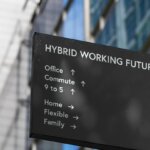Amazon and Apple join return-to-office pushback against remote working

• Amazon and Apple instigate back-to-office policies.
• Remote working under threat.
• “Back to work” policies suggest remote working is not “really” working.
During the Covid-19 pandemic, remote working was more or less mandated wherever it was deemed possible around the world. Certainly, traditional offices were decimated by the responsible actions taken to reduce the spread of Covid infection, and the rise and rise of technological solutions that acted to connect those who geographical distance prevented from congregating in one space.
From emergency to benefit.
What began – or at least grew to be accepted – in an emergency though soon revealed enormous potential benefits, both to staff and to employers who embraced the new remote working and eventually hybrid working models.
Staff were able to rearrange their lives in a more equitable work-life balance, and despite some initial (not to say shameful) paranoia from managers that involved the likes of pre-installed activity monitors on remote workers’ devices, the benefits largely revealed themselves to companies too.
READ NEXT

What is hybrid working in 2023?
The ability to hire the best people for the job, not just the best people who happened to live in an acceptable geographical proximity to the job, meant more varied, highly-skilled teams. It also opened up more teams to applicants with physical disabilities (for whom, for instance, a daily commute was a deal-breaker), and people who had domestic or caring responsibilities that couldn’t be left unattended for full days at a time.
The positives of this new arrangement certainly outweighed its negatives for many companies, with some even able to sell off expensive city real estate and realize equity that could be ploughed back into their business’ activities.
All of which makes a current trend of pushback against remote working significantly more baffling and wrong-headed.
And yet, it’s a trend that’s on the rise, setting staff – who have now settled into their remote working or hybrid working lifestyles – against the wishes of a wave of managers and companies demanding a “return-to-office” policy.
The Musk fiasco.
When technology’s leading edgelord, Elon Musk, took over Twitter, he famously tried to instigate a back-to-the-office policy, and his bluff was significantly called when large swathes of his staff chose their remote working lifestyle over the assumed prestige of working for one of the world’s leading social media platforms – a prestige that was to significantly plummet in the following months.
Now though, there’s more meaty, cross-industry support for putting an end to the remote working “experiment.”
Apple CEO Tim Cook’s plans to transition the company from remote working to a hybrid working model, skewed 3-2 days per week in favor of in-office working, went into operation yesterday.
Meanwhile, Amazon’s return-to-work policies will see some of its corporate workers walk out next week in protest, assuming the organizers can raise support from 1000 workers for the action.
While the arbitrary rearrangement of now-established lifestyle patterns is one concern, and the focus of remote working advocacy groups within the company, the Amazon action is also being part-organized by an internal climate justice worker group, which is highlighting another of the benefits of remote working – the significant decarbonization of operations brought about by remote working.
By killing the commute, not only do companies save worker-time and allow people’s workday to be more actively productive, they also take a lot of cars off the road at the same time of day, thus creating significantly fewer “choke points” on commuter roads, less congestion – and less pollution going into the atmosphere.
That could be particularly important at Amazon, as the company has pledged itself to achieve Net Zero (carbon neutrality across the company) by 2040.
A growing parcel of issues.
The Amazon action also comes after the announcement of significant layoffs – as is the case with many companies across the tech industry – and a particularly hostile response to Amazon workers attempting to unionize at warehousing facilities over pay and conditions.
In some cases, the Amazon response to those moves has been compared to old-style union-busting by the likes of the National Labor Relations Board (NLRB). It would be fair to say then that Amazon workers are amassing a number of grievances about the world’s “everything store,” and the question of an increasing push back into office culture could be one straw too many.
While the attempt to restore a pre-Covid office culture backfired badly when Elon Musk tried it, the attempts and arguments to bring workers back into office environments, in defiance of work-life balance concerns and environmental concerns both, have found a degree of surprisingly off-key support in some Western governments recently.
President Biden, in his 2022 state of the union address, said it was time for workers to “get back to work and fill our great downtowns again.” He followed that with the proclamation that show “People working from home can feel safe to begin to return to the office. We’re doing that here in the federal government. The vast majority of federal workers will once again work in person.”
Choice, not fear.
That seems to miss the mark on two counts – firstly, the assumption that, two years on from the Covid peak, it was mostly a fear of being “unsafe” that kept people working from home, and secondly the underlying implication that workers from home were not “properly” working, as there was a need for them to go “back to work.”
Besides, a year on, remote working remains popular among workers who do it.
Similar messaging has come more recently from UK Chancellor, Jeremy Hunt (Number 2 in the UK government and in charge of the country’s finances), when he said last week that “the default location for work should be the office.”
His comments, to the British Chamber of Commerce, were roundly condemned as representing an outdated cliché by many knowledgeable bodies, including the Chartered Institute of Personnel and Development (CIPD).
In the post-pandemic era there has been a lot of talk in the tech industry about remote working and hybrid working being “here to stay” and “the way of the future.” It’s worth remembering the degree of self-interest in statements like those – only by establishing hybrid and remote working as the new normal can the ecosystem of software companies that depend on connecting and managing remote and hybrid teams survive, so there’s a certain amount of self-interest in the narrative of certainty.
New waves of pushback.
Clearly, there will be more pushback on the issue of returning to in-office work than has been anticipated from managers and business owners, as well as high-level government figures up to and including the President of the US.
In that instance, the Amazon workers’ proposed walkout may be symbolic of a longer and more hard-fought battle between work-life balance advocates and climate campaigners on the one hand, and governments, management-driven companies and supplementary business owners (those who benefit from large workforces, for instance, needing places to get coffee, sandwiches, lunches, etc every day in a downtown location with a downtown price) on the other.
A result of that tension could be the rise in businesses with similar deliverables to those forcing workers back into the office, but which don’t make staff work from a central location (lowering their corporate overheads in the process).
Such businesses are unlikely to trouble the likes of Apple or Amazon, but might well use smart warehousing policies, for instance, to steal local or regional marches on the supergiants.










